Kopi Luwak denied Certification: the Dark Secret of the World's most expensive Coffee
For professional baristas, please follow the coffee workshop (Wechat official account cafe_style)
The raw material of civet coffee is coffee beans collected from civet droppings, but this is not good for civets.
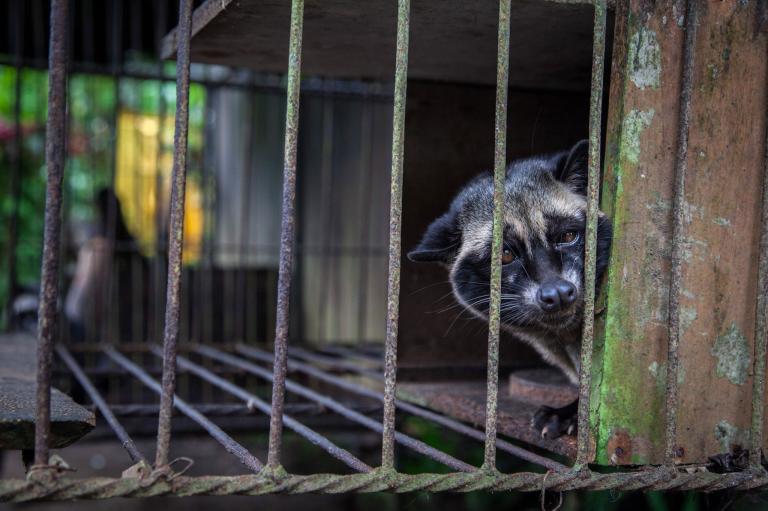
Captive civets sometimes only eat coffee fruits, but they also eat fruits, insects and reptiles in the wild. PHOTOGRAPH BY ULET IFANSASTI, GETTY IMAGES
The most expensive coffee in the world is made from poop ──, or more precisely, coffee beans that are half-digested and then pooped after being eaten by civets. This civet coffee is not cheap, and can be as high as $80 a cup in the United States.
The civet, which lives in Southeast Asia and sub-Saharan Africa, has a long tail like a monkey, a face like a raccoon, and stripes or spots on its body, which plays an important role in the food process. in addition to eating fruits such as coffee and mangoes, they also eat insects and small reptiles, and they are eaten by cheetahs, large snakes and crocodiles.
The civet coffee trade was supposed to do no harm to these animals: coconut cats, a species endemic to Asian palm civet; Southeast Asia, invade commercial orchards in Indonesia and are often seen as a pest by locals; as a result, the burgeoning civet coffee industry has prompted locals to protect civets for their precious droppings. The digestive enzymes in civets change the structure of proteins in coffee beans, removing some of the sour taste and making coffee more palatable.
However, civet coffee is becoming more and more popular, and Indonesia has become a tourist attraction for tourists to come into contact with wild animals, so more and more wild civets are kept in cages in coffee gardens. Part of this is to produce coffee, but also to earn civets' sightseeing money.
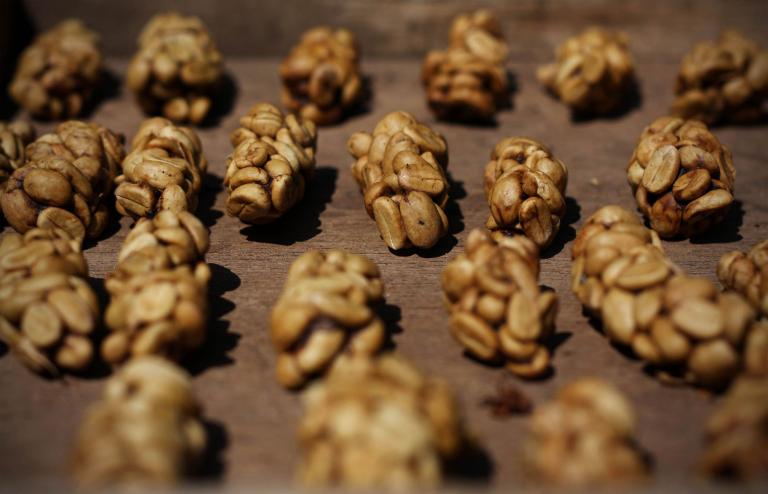
Civets have semi-digested coffee beans in their feces, which were previously collected from the wild, but more and more civets are locked up in coffee gardens and imprisoned in messy and crowded cages. PHOTOGRAPH BY ULET IFANSASTI, GETTY IMAGES
Researchers at the Wildlife Conservation and Research Service (Wildlife Conservation Research Unit) at the University of Oxford and the World Society for the Conservation of Animals (World Animal Protection) in London assessed the plight of nearly 50 caged wild civets in 16 coffee plantations in Bali, while a study published in the journal Animal Welfare found that the situation of the civets was not very optimistic.
Regardless of the size of the cage, sanitary conditions, or whether it can live a normal life like an ordinary civet, every coffee farm visited by the researchers did not meet the basic animal welfare conditions. "some cages are really too small," said Neil D'Cruze, one of the researchers. "We would say it's a rabbit cage and it's full of urine and feces. "
Cruz also said that some civets are skinny because they are only fed coffee fruit; some are fat because they can never move freely; and some civets behave abnormally by eating too much coffee. What saddens Cruz most, however, is the grid on which many civets are forced to stand or lie all the time: "if you stand on a grid like that all day, it will certainly cause pain and skin damage." They can't do without that kind of floor and endure pain and discomfort for a long time. "
In addition, many civets do not have clean drinking water or interact with other civets, and are even more exposed to the noise of traffic and crowds during the day, which is even worse for these nocturnal animals.
Source of beans: wild or farmed?
It's all for a luxury, and it's a second-rate one. Experts say what is special about civet coffee is that wild civets choose carefully when they eat coffee fruit, but keeping them in a cage and feeding casual coffee fruit will not produce much better products.
In addition, a coffee expert said in an article by the American Fine Coffee Association (Specialty Coffee Association of America) that civet coffee was not so good either: although the civet's digestion does make the coffee more palatable, it also removes good acidity and flavor, which are the characteristics of fine coffee.
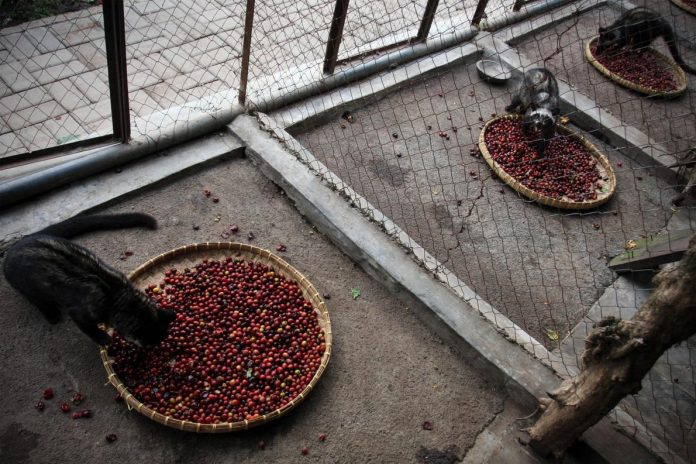
A civet is likely to be caught in a cage from the wild in order to produce the world's most expensive civet coffee. PHOTOGRAPH BY NICKY LOH, GETTY IMAGES FOR WSPA
At present, there is no way to tell whether the civets coffee beans come from wild or captive civets. BBC conducted a secret survey in 2013 and found that some of the coffee billed as wild civets in Europe came from captive civets that were treated inhumanely.
Even Tony Wild, a coffee trader that introduced civet coffee to the West, argued in an article in the Guardian that civet coffee should not be drunk. He said that the coffee has become more and more industrial production, but also become more abusive to animals, often fakes.
Today, there is no certification mechanism to prove that "wild" coffee is really wild; in addition, other coffee certification bodies ensure reliable coffee cultivation and production, but they also refuse to certify civet coffee.
The Rainforest Association (Rainforest Alliance) in New York and other well-known coffee certification bodies issue certification marks based on the standards of the Sustainable Agriculture Network (Sustainable Agriculture Network;, referred to as SAN), which forbids farm hunting of wild animals, and SAN regulations for Indonesian coffee explicitly prohibit civets kept in cages.
UTZ is another important certification standard for sustainable coffee, which also prohibits caging wild animals on farms and refuses to certify civet coffee.
Alex Morgan of the Rainforest Association says the risk of certifying civet coffee is too high because there is no way to ensure that the beans are 100% wild. "my personal advice is to avoid this coffee as much as possible, which usually comes from caged animals," he said. "
Important Notice :
前街咖啡 FrontStreet Coffee has moved to new addredd:
FrontStreet Coffee Address: 315,Donghua East Road,GuangZhou
Tel:020 38364473
- Prev
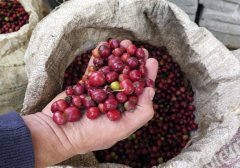
Information on coffee producing areas in Ecuador High altitude and High quality Coffee in Galapagos Islands
Professional barista communication follow coffee workshop (Wechat official account cafe_style) Ecuadorian population: Ecuadorian coffee is increasingly prominent in the boutique coffee industry, although low-lying areas are unlikely to produce good coffee, but higher areas have great potential. Galapagos Islands GALAPAGOS a small amount of coffee produced in the Galapagos Islands, it supports
- Next
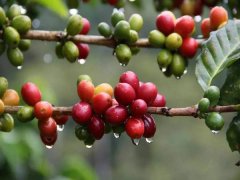
What are the advantages and disadvantages of Guatemalan coffee? Why is it so popular?
Communication of professional baristas Pacamara Coffee, a gift from the coffee workshop (official Wechat account cafe_style), is a hybrid of Pacas Pacas (a sudden variant of the bourbon species) and giant bean Maragogype (elephant bean) found in El Salvador in the 1950s. The origin of the name Maragogype and the first four letters of Pacas Pacas are combined into Pacamara. Paka
Related
- Detailed explanation of Jadeite planting Land in Panamanian Jadeite Manor introduction to the grading system of Jadeite competitive bidding, Red bid, Green bid and Rose Summer
- Story of Coffee planting in Brenka region of Costa Rica Stonehenge Manor anaerobic heavy honey treatment of flavor mouth
- What's on the barrel of Blue Mountain Coffee beans?
- Can American coffee also pull flowers? How to use hot American style to pull out a good-looking pattern?
- Can you make a cold extract with coffee beans? What is the right proportion for cold-extracted coffee formula?
- Indonesian PWN Gold Mandrine Coffee Origin Features Flavor How to Chong? Mandolin coffee is American.
- A brief introduction to the flavor characteristics of Brazilian yellow bourbon coffee beans
- What is the effect of different water quality on the flavor of cold-extracted coffee? What kind of water is best for brewing coffee?
- Why do you think of Rose Summer whenever you mention Panamanian coffee?
- Introduction to the characteristics of authentic blue mountain coffee bean producing areas? What is the CIB Coffee Authority in Jamaica?

